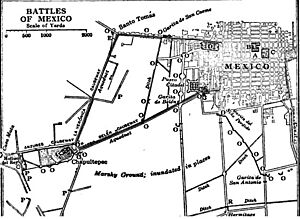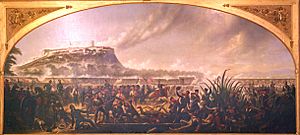Battle for Mexico City facts for kids
Quick facts for kids Mexico City Campaign |
|||||||
|---|---|---|---|---|---|---|---|
| Part of the Mexican–American War | |||||||
 The American assault on Chapultepec Castle. |
|||||||
|
|||||||
| Belligerents | |||||||
| Commanders and leaders | |||||||
| Strength | |||||||
| 20,000 | 13,000 | ||||||
| Casualties and losses | |||||||
| 1,651 killed or wounded | 2,323 killed or wounded 3,000 captured |
||||||
The Battle for Mexico City was a series of important fights that happened from September 8 to September 15, 1847. These battles took place around Mexico City during the Mexican–American War. Key parts of this campaign included the battles of Molino del Rey and Chapultepec. The fighting ended when Mexico City fell to the American forces. The U.S. Army, led by Winfield Scott, won a major victory that helped bring the war to an end.
Contents
Why Mexico City Was Important
The main goal for the American army in central Mexico was to capture Mexico City. After taking the port of Veracruz in March, General Winfield Scott set up a base. He then moved inland and defeated a large Mexican force at the Battle of Cerro Gordo. After another victory at the Battle of Churubusco, Scott's army was very close to Mexico City. They were less than eight kilometers (five miles) away from their target.
Key Battles
Molino del Rey: The King's Mill
The fight for Mexico City started on September 8. General Scott thought there was a cannon factory at a place called Molino del Rey, which means "King's Mill." This mill was about three kilometers (two miles) outside the city. Scott sent the 1st Division, led by William J. Worth, to capture and destroy the factory. Worth wanted to include Chapultepec Castle in his attack, but Scott said no. This disagreement caused a rivalry between the two generals.
During the battle, both sides lost many soldiers. Worth's troops pushed the Mexican forces away from the mill. This separated them from the soldiers at Chapultepec. However, the battle did not give the U.S. army any major military advantages.
Chapultepec Castle: A Heroic Defense
The main attack on Mexico City happened a few days later, on September 12. Mexico City was partly protected by Chapultepec Castle. This castle was being used as a military academy for young cadets. Scott started the attack with a full day of artillery fire on September 12.
The next day, September 13, the 4th Division, led by John A. Quitman, led the charge against Chapultepec. They successfully captured the castle. Future Confederate generals George E. Pickett and James Longstreet were part of this attack. Young Mexican cadets, later known as Los Niños Héroes (the "Boy Heroes"), bravely defended the castle. After the castle fell, the Mexican forces pulled back into the city.
Fighting at the City Gates
After Chapultepec, the American forces pushed towards the city's main gates. Quitman's Division moved along the Belén Causeway towards the Belén Gate. This gate was defended by Mexican General Terres and Colonel Garay. Meanwhile, Worth's Division, further north, advanced along the La Verónica Causeway towards the San Cosme Gate. General Rangel's infantry brigade defended this gate.
Quitman was only supposed to pretend to attack the city. But he pushed his entire division forward and broke through the defenses at Belén Gate. Antonio López de Santa Anna, the Mexican general, arrived at the gate very angry and removed the commander there. Worth's Division had a slow start against the Mexicans. They first had to fight off a Mexican cavalry attack. When Worth reached San Cosme, he found its defenses not well prepared. However, the Mexican defenders fought hard before retreating.
Ulysses S. Grant, who would later become a U.S. president, also took part in the fighting. He helped lift a cannon into the bell tower of a nearby church. From this high spot, Grant fired down on the Mexican defenders. When the fighting stopped, both gates had fallen. The Mexican forces had withdrawn deeper into the city.
Mexico City Falls

During the night, the Mexican army, led by a group of generals, left the city. They took their cannons and most of their soldiers with them. The U.S. forces expected another attack, but they found the city undefended. Worth and Quitman's divisions moved carefully into the city.
General Scott gave Quitman's Division the honor of formally entering Mexico City. The American troops looked tired and their uniforms were ragged. Quitman himself only had one shoe when he marched into the city. Quitman's troops marched into the Zócalo plaza, the main square in the city. The formal surrender took place in front of the National Palace.
Some Mexican soldiers who were left behind after Santa Anna's army left climbed onto rooftops. They started shooting at the American soldiers. General Garland was hit in the chest and badly wounded. Before leaving, Santa Anna had also released 30,000 prisoners into the streets. These rooftop shots encouraged the prisoners to also attack the American soldiers. Worth's troops managed to get the shooting under control.
William S. Harney's cavalry escorted General Scott into the city. Scott wore his perfect dress uniform and was greeted with patriotic music. Scott chose Quitman to be the military governor of the city. This made Quitman the only American to ever rule from the National Palace.
Casualties
Here are the numbers of soldiers killed, wounded, or captured during the battles:
September 8 (Molino del Rey)
- U.S. forces: 116 killed, 665 wounded, 17 missing. Total: 789.
- Mexican forces: 2,700 total.
September 12–15 (Chapultepec and City Gates)
- U.S. forces: 130 killed, 703 wounded, 29 missing. Total: 862.
- Mexican forces: 1,800 killed and wounded, 823 captured. Total: 2,623.
Overall Totals
- U.S. forces: 1,651 soldiers killed or wounded.
- Mexican forces: 5,323 soldiers killed, wounded, or captured.
See also
 In Spanish: Batalla de la Ciudad de México para niños
In Spanish: Batalla de la Ciudad de México para niños



